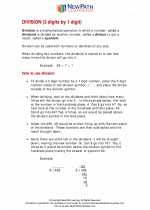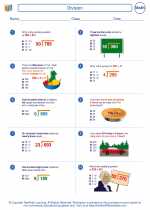Constants in Mathematics
In mathematics, a constant is a value that does not change. It is a fixed value that remains the same regardless of any other variables or factors. Constants are used in various mathematical equations, formulas, and expressions.
Types of Constants
There are different types of constants in mathematics:
- Numeric Constants: These are specific numerical values such as 3, 5, 0.5, etc.
- Physical Constants: These are values that represent physical quantities, such as the speed of light (c), gravitational constant (G), etc.
- Mathematical Constants: These are special values that arise in mathematical calculations, such as π (pi), e (Euler's number), etc.
Examples of Constants
Here are some examples of constants:
- The value of π (pi) is approximately 3.14159.
- The speed of light in a vacuum is approximately 299,792,458 meters per second.
- The gravitational constant (G) is approximately 6.674 × 10-11 m3 kg-1 s-2.
- The value of e (Euler's number) is approximately 2.71828.
Study Guide
To understand constants better, here are some key points to remember:
- Understand the concept of a constant as a fixed value that does not change.
- Identify different types of constants, such as numeric, physical, and mathematical constants.
- Memorize important mathematical constants like π and e, as they are commonly used in various mathematical calculations.
- Learn to recognize constants in equations and expressions, and distinguish them from variables.
Practice solving problems and equations involving constants to strengthen your understanding of their role in mathematics.
Conclusion
Constants are essential components of mathematical concepts and calculations. Understanding their role and significance will help you in various mathematical applications and problem-solving.
.◂Math Worksheets and Study Guides Sixth Grade. Division
Study Guide Division
Division  Worksheet/Answer key
Worksheet/Answer key Division
Division  Worksheet/Answer key
Worksheet/Answer key Division
Division  Worksheet/Answer key
Worksheet/Answer key Division
Division 

 Worksheet/Answer key
Worksheet/Answer key
 Worksheet/Answer key
Worksheet/Answer key
 Worksheet/Answer key
Worksheet/Answer key

The resources above cover the following skills:
Connections to the Grade 6 Focal Points (NCTM)
Number and Operations: Students' work in dividing fractions shows them that they can express the result of dividing two whole numbers as a fraction (viewed as parts of a whole). Students then extend their work in grade 5 with division of whole numbers to give mixed number and decimal solutions to division problems with whole numbers. They recognize that ratio tables not only derive from rows in the multiplication table but also connect with equivalent fractions. Students distinguish multiplicative comparisons from additive comparisons.